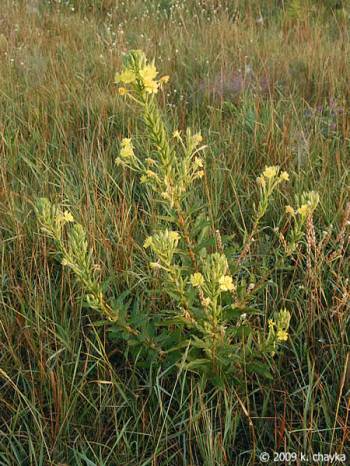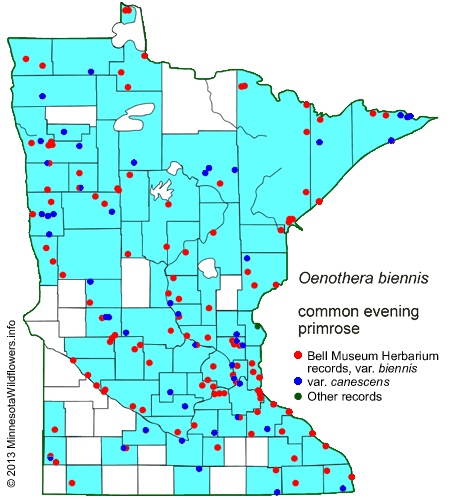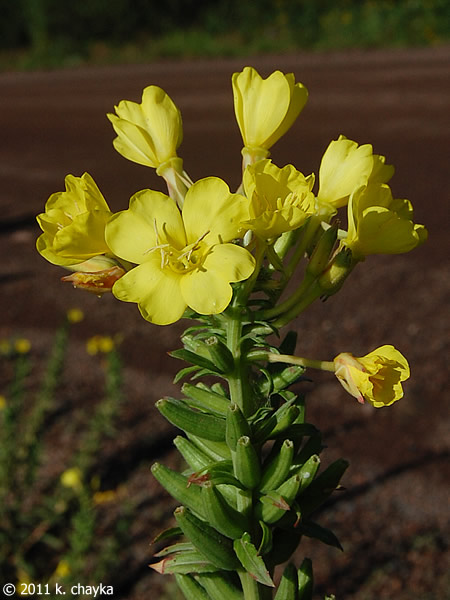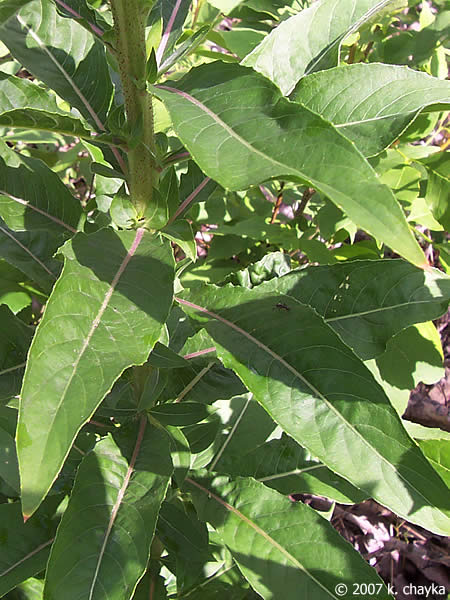
General Information
Oenothera biennis, known as the common evening primrose, has a range native to both North and South America. In Minnesota evening primrose can be found scattered throughout the state. Evening primrose prefers to grow in part shade and sun located on the edges of forests and streams. This plant is a biennial, which is a short-lived perennial. The flowers will bloom between July and October and can grow 2 to 6 feet tall. This plant is most identifiable by its beautiful, yellow flowers. On each flower there is 4 yellow petals, about 1-2 inches across. It is unique that the stigma, in the center of the flower, is cross-shaped. The leaves are lanceolate and up to 8 inches long.


Evening primrose flowers

Evening primrose leaves
Medicinal Uses
Traditionally, evening primrose was used as a medicinal plant for the Native Americans. They would utilize the entire plant for its bruise healing properties, and its roots specifically for hemorrhoids. Leaves were used to treat small wounds, gastrointestinal problems, and sore throat. Currently, individuals are taking evening primrose oil orally to improve conditions of eczema, rheumatoid arthritis, premenstrual syndrome, breast pain, and menopause. Evening primrose oil is safe to take in a short-term timeframe, except for individuals who are pregnant or are on blood thinning medication.
Chemical Constituents
The most notable chemical components in the evening primrose are several fatty acids and alcohols. The fatty acids found in this plant include gamma-linolenic acid, linoleic acid, oleic acid, palmitic acid, and stearic acid. These are components are important because the human body does not make fatty acids and they are crucial for normal growth and development. Fatty alochols include hexacosanol, tetracosanol , docosanol and octocosanol. It is hypothesized that fatty alcohols assist in cholesterol metabolism.
Current Research
Some traditional uses of evening primrose are supported by research. One group of researchers found that the fatty alcohol chains found in evening primrose oil promotes an anti-inflammatory response in peritoneal macrophages (Montserrat-de la Paz et al. 2014). In another study, a researcher demonstrated that evening primrose oil reduced diabetic effects in rats (Olman, 2012). When the evening primrose treated group’s blood and tissues were sampled, it was found that their veins were less thick and their pancreas had less fatty degeneration than untreated diabetic rats.
Sources
“Chemical Information Review Document for Evening Primrose Oil (Oenothera biennis L.).” National Institutes of Health. November 2009. Accessed March 12, 2017. https://ntp.niehs.nih.gov/ntp/noms/support_docs/evening_primrose_nov2009.pdf.
“Evening Primrose Oil.” National Institutes of Health. November 30, 2016. Accessed March 12, 2017. https://nccih.nih.gov/health/eveningprimrose.
“Oenothera biennis (Common Evening Primrose).” Minnesota Wildflowers. Accessed March 12, 2017. https://www.minnesotawildflowers.info/flower/common-evening-primrose.
Omran, Ola M. 2012. “Histopathological Study of Evening Primrose Oil Effects on Experimental Diabetic Neuropathy.” Ultrastructural Pathology 36, no. 4: 222-227. Health Source: Nursing/Academic Edition, EBSCOhost (accessed March 15, 2017).
Montserrat-de la Paz, S., M. D. García-Giménez, M. Ángel-Martín, M. C. Pérez-Camino, and A. Fernández Arche. 2014. Long-chain fatty alcohols from evening primrose oil inhibit the inflammatory response in murine peritoneal macrophages. Journal of Ethnopharmacology 151 (1): 131-6.
Page created by Hannah Lipps
